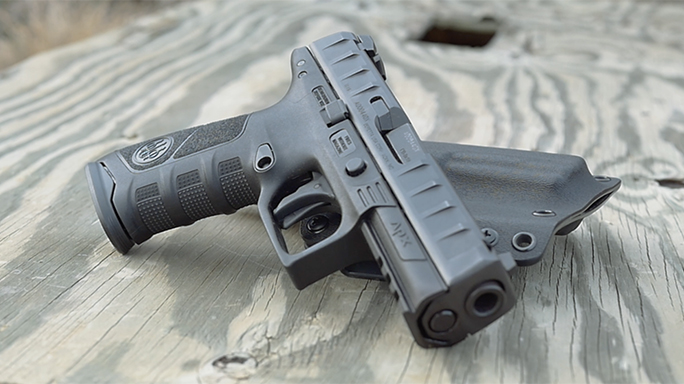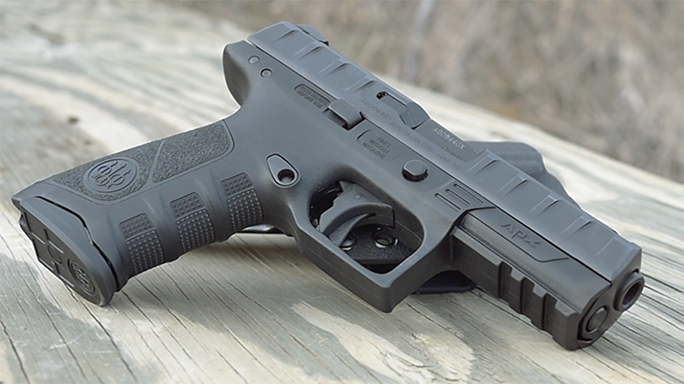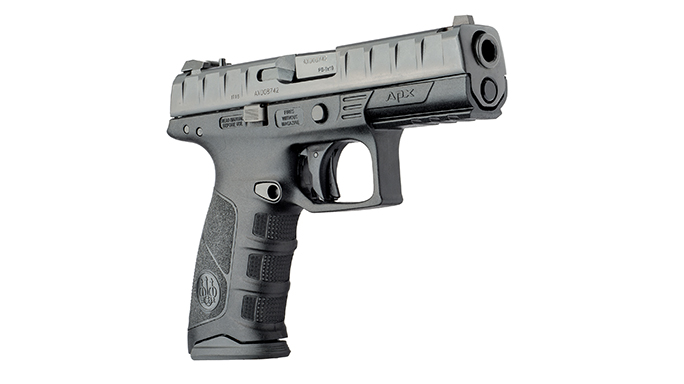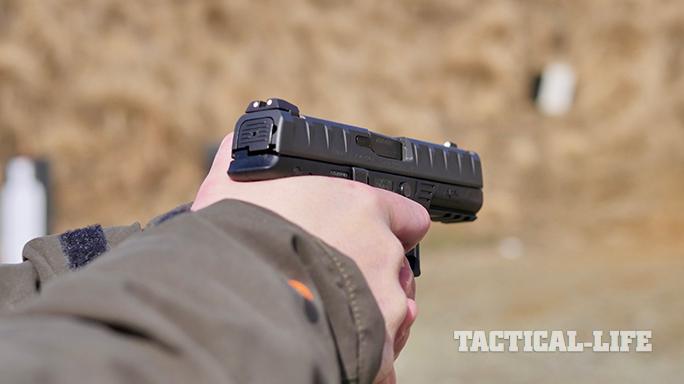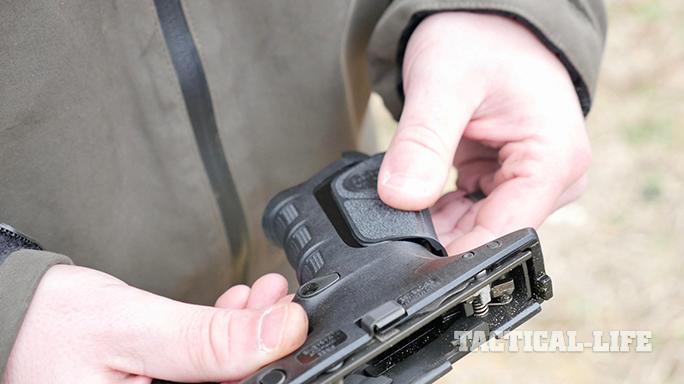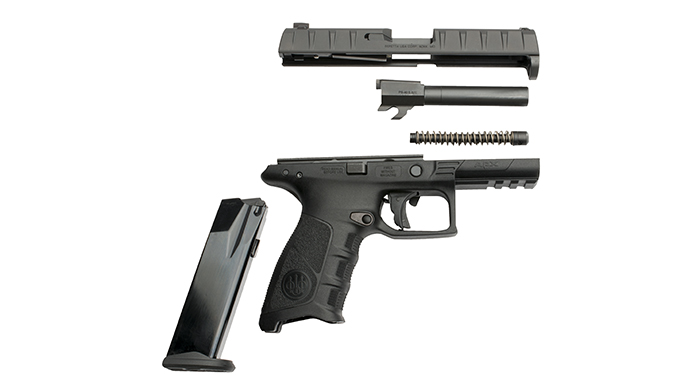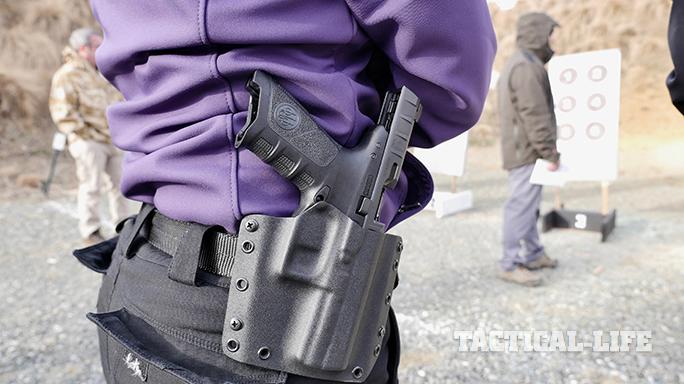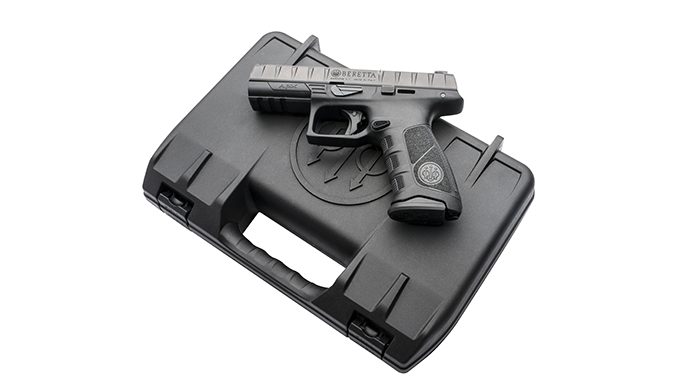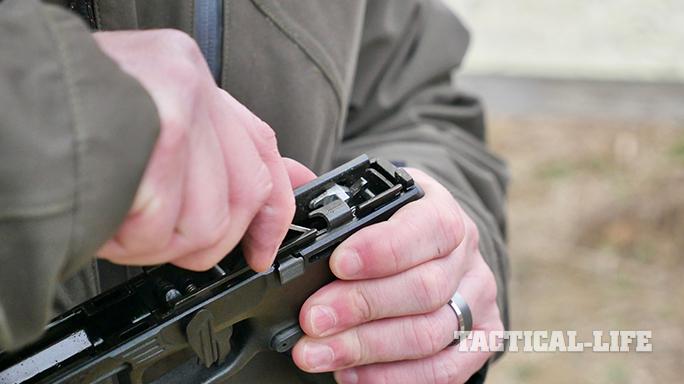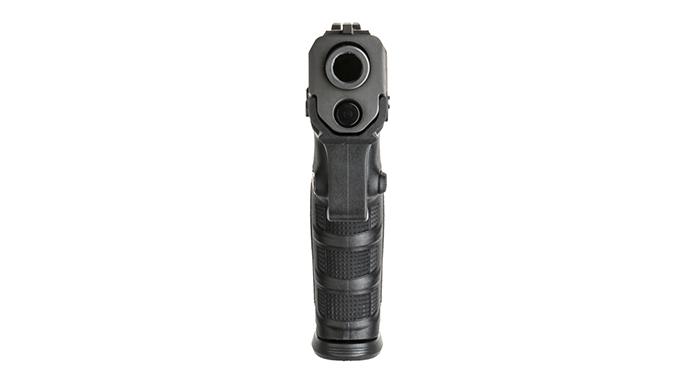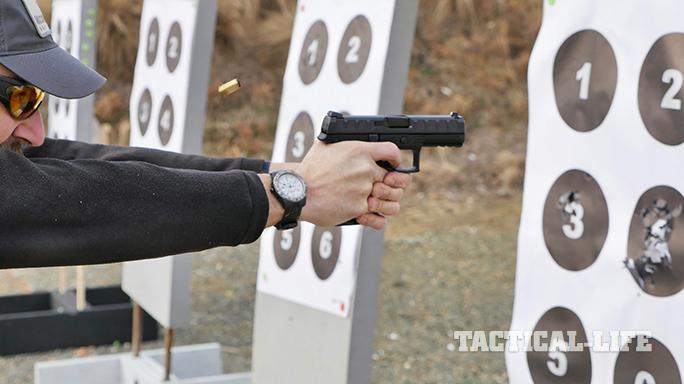Beretta hosted its second Tactical Summit Feb. 14 and 15 at the O’Gara Training Center in Virginia, where industry insiders got an exclusive look at the Beretta APX.
The APX was the centerpiece of the Beretta Tactical Summit 2.0 and for good reason, as it represents a refocusing of Beretta’s attention toward the tactical market.
The slogan that Beretta has adopted for the APX is only three words long, but it carries a substantial message: “Win the fight!”
Advertisement — Continue Reading Below
- RELATED STORY: Beretta M9A3: A Battle-Enhanced 9mm Pistol
The implication is clear: If you have a fight that you need to win, the APX is the tool you want in your hand to help make that happen. So far, my limited but positive experience with the Beretta APX leads me to believe that the APX delivers on Beretta’s slogan.
Overview
The Beretta APX, as it currently exists, is a duty sized, modern striker-fired handgun chambered in 9mm and 40 S&W. The barrel length of the APX is 4.25 inches and the trigger is a wide, flat faced design that is housed in an oversized trigger guard to accommodate gloved fingers. Its trigger features a tab safety and performs well with a 6-pound, relatively clean, relatively crisp press. The APX operates off a tilt barrel, locking breech and incorporates a push button that allows the user to deactivate the striker system so that disassembly can take place without pressing the trigger.
The core of the APX is a stainless steel, serialized chassis. It is this chassis system that allows the APX to achieve its modular nature.
Advertisement — Continue Reading Below
Beretta’s black, modular, polymer grip is fiberglass filled, comfortable, and fits a wide variety of hands well due to its interchangeable back straps. In front of the trigger guard is a standard rail system for the mounting of a variety of accessories. The magazine release is swappable from side to side and the slide catch lever is ambidextrous and is designed to operate both as a slide catch and a slide release.
The slide comes with a matte black finish and incorporates features that exploit the gun’s simplicity. A low bore axis helps to reduce felt recoil and provide for faster follow-up shots and the slide has aggressive serration from front to back to make sure you can work the action regardless of where you grip it. On top of the slide mounted in proprietary dovetail cuts are low profile three dot sights. Both front and rear are drift adjustable.
Target Audience
The development of the Beretta APX seems to have been a methodical and intentional process.
Advertisement — Continue Reading Below
While at the Tactical Summit 2.0, it was explained that the roots of the APX stemmed not from the imagination of a designer, but instead from the needs of the end user. More than 500 law enforcement officers, SWAT operators, military personnel and defensive trainers were consulted on what they needed most from a tactical duty handgun. That information was compiled and considered, then incorporated into the design.
The input didn’t stop there. When the prototypes were ready, they didn’t just get tested on the production range; instead, they headed back to those that gave the input to make sure that the spirit of their needs was captured in the design. Rinse, repeat and four years later we have an APX specifically designed to #WinTheFight.
It follows simply that since the APX was designed with input from those that depend on a handgun to win the fight, that the tactical operator is the intended end user of the APX. It is a full-size duty gun intended for duty use — military, SWAT, law enforcement use. It isn’t intended as a concealed carry or competition gun, but the modularity of the gun should lead toward a high performance in those areas as well.
Advertisement — Continue Reading Below
Only time will tell where this pistol will shine.
Key Characteristics of a Fighting Handgun
Although we could argue for days about which aspects of a modern fighting handgun might be most important, I would imagine that most folks that understand the handgun as the solution to lethal violence would agree on the same aspects that Beretta set as priorities for the APX. Let’s take a look at these priorities.
Reliability
Advertisement — Continue Reading Below
A defensive handgun needs to function. Accepting that all mechanical devices eventually fail, you should expect a very high level of reliability from a fighting handgun. Every time you press, the trigger the gun should function.
Durability
Duty Guns are often subjected to harsh conditions. They can spend a long time in the holster without being shot, inspected and maintained all the while exposed to the elements and the abuse of being carried in a duty holster. Then, with no notice, the gun needs to function with perfection in a high stakes environment. This makes durability paramount.
Advertisement — Continue Reading Below
Ergonomics
In today’s world, it seems that ergonomics is where much of the progress in handgun design is being made and with good reason: All other things the same, a gun that fits the user is more efficient that a gun that doesn’t. With quality ergonomics, the user can work the trigger with more precision and speed, manage recoil with more command and operate the controls of the gun to make reloads quicker and malfunction clearance easier. Easier operation means less effort to manipulate the gun and more effort directed to other critical tasks.
Trigger
Advertisement — Continue Reading Below
I’m not a trigger snob. I have spent the time needed to shoot any reasonable trigger well. At the same time, a quality trigger can reduce both the physical and mental workload on the shooter. When it comes to dealing with violence, a quality trigger allows that mental and physical horse power to be redirected to other tasks. Again, we are talking about efficiency.
Modularity
In recent years, modularity has become an important aspect of many quality defensive handguns. When it comes to use within an agency or military unit, having a handgun that can be adapted to individual shooters and specific situations makes tremendous logistical sense. Chassis guns like the APX excel at modularity offering improved ergonomics and adaptability.
Advertisement — Continue Reading Below
Shooting the Beretta APX
On the square range, the APX performed as would be expected. It ran reliably, it seemed durable, had decent ergonomics, had a solid performing trigger and the modularity proved to be a benefit. Where the APX seemed to excel was when the gun, and the shooter, were pressed. Over the course of the Tactical Summit I fired approximately 600 rounds through the APX. Every time I pressed the trigger, the gun went bang and the shot landed where I put it.
- RELATED STORY: The 20 Best Guns For Law Enforcement in 2016
The conditions weren’t perfect. It was winter in Virginia (so maybe pseudo winter) — about 45 degrees and wet. I shot with gloved hands from start to finish. In the first 50 or so rounds, I pulled three shots low and left on the 8 inch circles at 7 and 10 yards strong hand and support hand only. Not my best performance, but, the gun did exactly what I told it to do and nothing the modularity of the APX couldn’t help fix.
Over the course of the 600 rounds and two days of shooting I experienced no malfunctions. This isn’t a miraculous feat. It is simply expected of a fighting handgun. More impressive is that the only malfunctions I heard of from 15 shooters over two days were failures to feed immediately following a slide-lock reload.
One of the instructors graciously conceded that the malfunctions could be the result of aggressive slide serrations and gloves keeping the slide from slamming home under the full pressure of the recoil spring. A kind statement that probably covered for the common user error of riding the slide home. Gun writer egos must be protected …
The APX really started to shine when the context became more complex. We had the opportunity to run the gun in a variety of contexts:
- On the square range in realistic defensive drills
- In no-light scenarios where a handheld light commanded physical and mental resources
- In a low-light environment with NVGs where depth perception and spatial awareness were compromised
- In a live-fire shoot house where tactical complexity depleted the focus on shooting skills
The APX performed solidly regardless of the conditions that we forced it into. It performed reliably and comfortably placing multiple rounds in accordance to the skill I applied to the gun. It was as if I was running my personal carry gun with a slightly better trigger and a significantly better fit.
Beretta shared with us that we were shooting bone stock production guns. I certainly want to spend more time with an APX in difficult circumstances to test the pistols limits and hear reports from other folks who put the APX through its paces. Only time will tell how the gun performs in the environments and contexts it was designed for, but I would have to say that the APX is off to a running start.
The Beretta APX and Modularity
Although I didn’t have the opportunity to see the full range of modularity that the APX will have to offer while at the Beretta Tac Con 2.0, it isn’t terribly difficult to see what is coming down the road. What was present was a solid start on a truly modular handgun platform.
Modularity and Fit
Like other guns in the modular niche, the Beretta APX consists of a serialized chassis system housed in a grip frame and topped off with an upper receiver. Within the first 30 minutes of shooting the APX, I was ready for a change to the system. My hands are average size and when they hold a typical double stack 9mm handgun, it is a bit of a stretch. The problem is that handgun fit is important yet often ignored.
When a gun is too large it can be more difficult to shoot well. The modularity of the APX accounts for different size hands by offering different size interchangeable back straps. I asked for a small back strap and a few moments later I had a better fitting APX in my hand. The smaller grip made it easier to put my trigger finger on the face of the flat trigger and easier to grasp the gun all the way around the circumference of the grip. This led to a perception of more recoil control, faster follow-up shots, and an increase in accuracy and precision — these are all good things.
Modularity and Visual Appeal
In addition to the interchangeable back straps, Beretta had the different colored modules of the Beretta APX available to peruse. The grips and back straps are available in black, olive drab green, flat dark earth and gray. This provides the end user with some options for visual customization. Chappy’s APX wore a ODG grip with a black back strap and it was visually appealing for sure.
The ability to combine popular colors means that you can have your gun looking like a custom work without expensive coatings.
Modularity and Logistics
The modularity of the Beretta APX is about more than just fit and good looks. When the full APX line is ready to rock, it is reasonable to expect that you will be able to swap calibers and grip lengths just like you can currently with the SIG P320.
For law enforcement and military application, this provides a modular handgun that solves logistical issues with a few minutes and a few simple tools as opposed to the purchase of a new firearm.
If an officer moves from patrol to the detectives bureau and needs a small gun for plain clothes carry, the solution is simple: Swap out the 17-round grip for the anticipated 15-round grip, change out the full-size top end for the compact top end, and for a fraction of the cost of a new gun you have, well, a new gun.
Modularity and Modifications
For the armed citizen, there are advantages as well that go beyond the fit issues I solved. For years, I have carried a Glock 17 handgun with the grip cut off to the length of a Glock 19. I talk about why I carry that combination on the Safety Solutions Academy Podcast here. In simple terms, it really comes down to comfort and the ability to conceal the handgun.
Here is the thing, I have a major problem with the process I go through to create my custom carry gun. When I bought my Glock 17, I took it to a gunsmith and had him cut my brand new gun to accept Glock 19 mags. It was an extra cost to have the work done, it took time, and worst of all, it destroyed the value of my new gun to the rest of the world.
Ugh.
With a gun like the future Beretta APX, a small investment in a compact length grip, a few minutes in swapping the chassis from one grip to another, a new magazine or two, and you are off to the races. If you change your mind, simply rewind time, undo what you did and you are back to square one. The modularity of the chassis guns like the APX is a real step forward when it comes to the user’s ability to tailor the gun to their specific needs.
Final Thoughts
As I watch product design and launch efforts in the firearms industry, it is becoming apparent that more and more companies are taking advantage of the knowledge of their end users to build the products that those users want and, more importantly, need.
- RELATED STORY: 12 Last-Ditch Backup Pistols For Law Enforcement
From the outside looking in, it appears that Beretta has taken a logical and common sense approach to the development of the APX. I am looking forward to tracking the launch of the APX, how it is received and how it performs as it works its way into the tactical handgun niche. In addition, I am excited to get a hold of the testing and evaluation model from Beretta so that I can really put the gun through the wringer.
What I know for sure is that Beretta has done their homework and studied up on what a tactical handgun needs to be to #WinTheFight. What is left to find out is, will they?
The Beretta APX will be available April 15. For more information on the Beretta APX, please visit WinTheFight.com.
